Analysis: Technology for Independent Living & Healthcare Impact
VerifiedAdded on 2024/05/30
|14
|4826
|178
Report
AI Summary
This report examines the role of technology in supporting independent living, focusing on the experiences of individuals like Sally and Maggie. It details how assistive technology can aid individuals with disabilities in performing daily tasks, communicating, and maintaining their independence. The report identifies barriers to technology adoption, including potential device failures, battery dependence, and financial costs. It also discusses the benefits of key healthcare technologies, such as improved accessibility and recovery processes. Furthermore, the report addresses safety and health considerations related to technology use, emphasizing the importance of security checks and the potential long-term effects on health. Ethical considerations, such as the potential for misuse and the impact on patient autonomy, are also explored. The report concludes by highlighting the impact of emerging technologies on healthcare services, care workers, and organizations, emphasizing the need for careful evaluation and implementation.
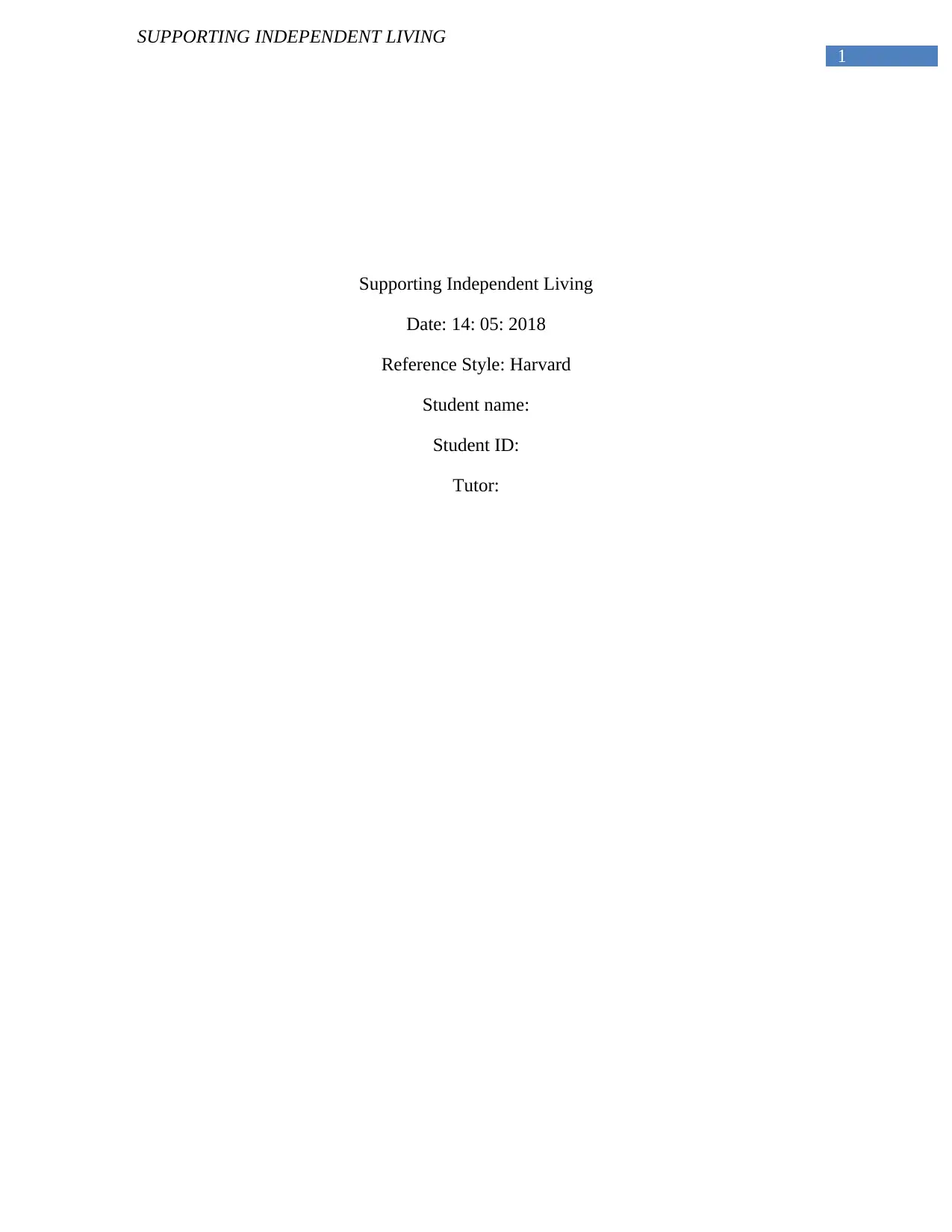
1
SUPPORTING INDEPENDENT LIVING
Supporting Independent Living
Date: 14: 05: 2018
Reference Style: Harvard
Student name:
Student ID:
Tutor:
SUPPORTING INDEPENDENT LIVING
Supporting Independent Living
Date: 14: 05: 2018
Reference Style: Harvard
Student name:
Student ID:
Tutor:
Paraphrase This Document
Need a fresh take? Get an instant paraphrase of this document with our AI Paraphraser
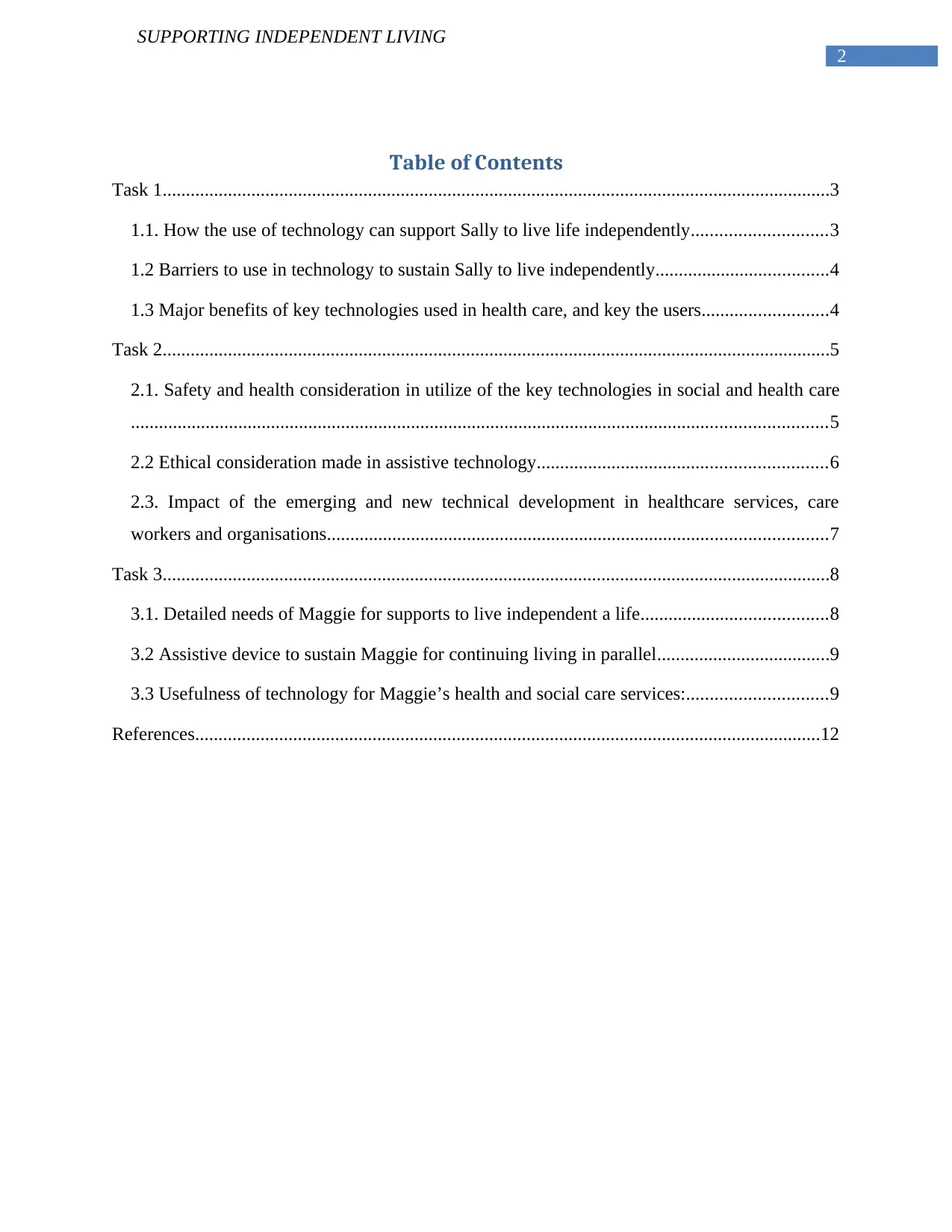
2
SUPPORTING INDEPENDENT LIVING
Table of Contents
Task 1...............................................................................................................................................3
1.1. How the use of technology can support Sally to live life independently.............................3
1.2 Barriers to use in technology to sustain Sally to live independently.....................................4
1.3 Major benefits of key technologies used in health care, and key the users...........................4
Task 2...............................................................................................................................................5
2.1. Safety and health consideration in utilize of the key technologies in social and health care
.....................................................................................................................................................5
2.2 Ethical consideration made in assistive technology..............................................................6
2.3. Impact of the emerging and new technical development in healthcare services, care
workers and organisations...........................................................................................................7
Task 3...............................................................................................................................................8
3.1. Detailed needs of Maggie for supports to live independent a life........................................8
3.2 Assistive device to sustain Maggie for continuing living in parallel.....................................9
3.3 Usefulness of technology for Maggie’s health and social care services:..............................9
References......................................................................................................................................12
SUPPORTING INDEPENDENT LIVING
Table of Contents
Task 1...............................................................................................................................................3
1.1. How the use of technology can support Sally to live life independently.............................3
1.2 Barriers to use in technology to sustain Sally to live independently.....................................4
1.3 Major benefits of key technologies used in health care, and key the users...........................4
Task 2...............................................................................................................................................5
2.1. Safety and health consideration in utilize of the key technologies in social and health care
.....................................................................................................................................................5
2.2 Ethical consideration made in assistive technology..............................................................6
2.3. Impact of the emerging and new technical development in healthcare services, care
workers and organisations...........................................................................................................7
Task 3...............................................................................................................................................8
3.1. Detailed needs of Maggie for supports to live independent a life........................................8
3.2 Assistive device to sustain Maggie for continuing living in parallel.....................................9
3.3 Usefulness of technology for Maggie’s health and social care services:..............................9
References......................................................................................................................................12
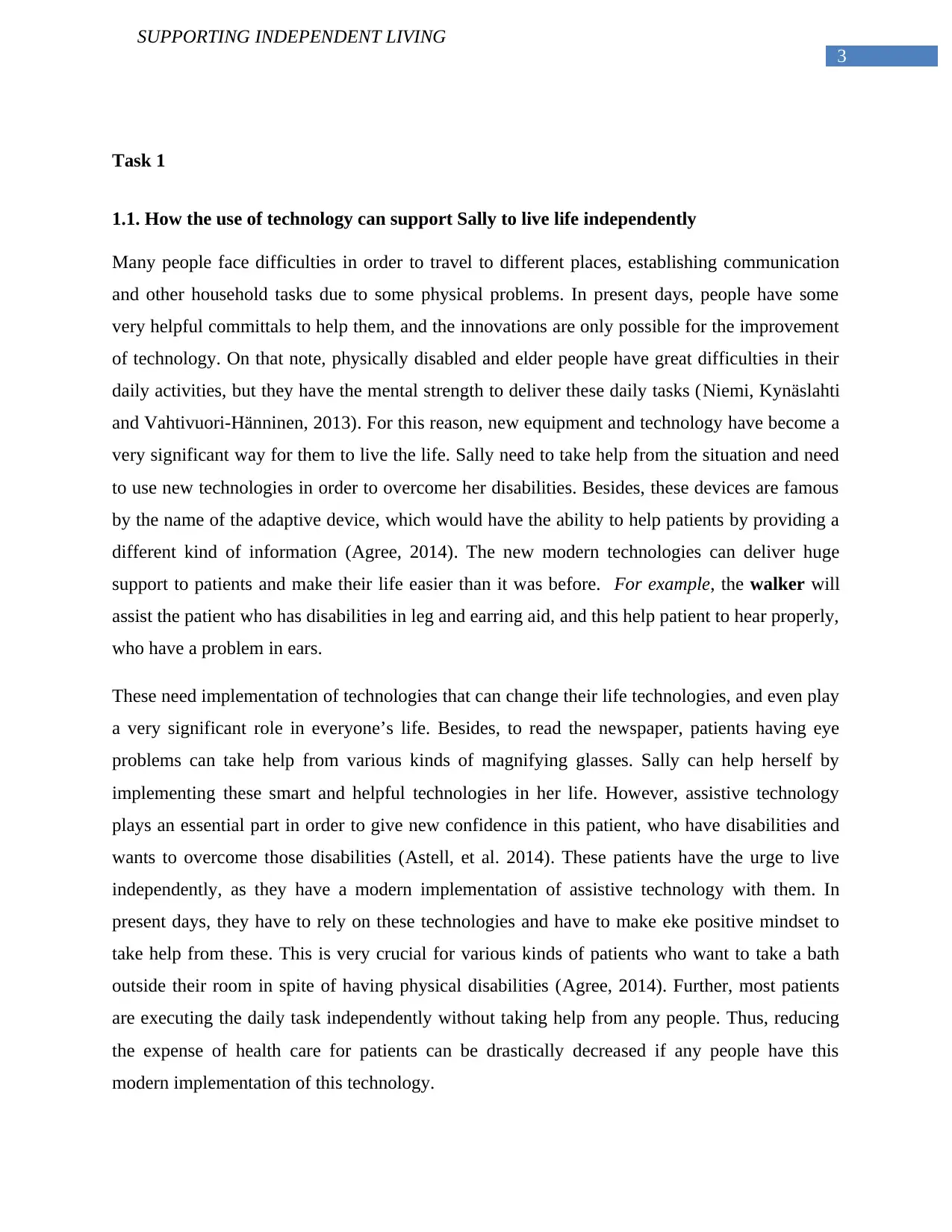
3
SUPPORTING INDEPENDENT LIVING
Task 1
1.1. How the use of technology can support Sally to live life independently
Many people face difficulties in order to travel to different places, establishing communication
and other household tasks due to some physical problems. In present days, people have some
very helpful committals to help them, and the innovations are only possible for the improvement
of technology. On that note, physically disabled and elder people have great difficulties in their
daily activities, but they have the mental strength to deliver these daily tasks (Niemi, Kynäslahti
and Vahtivuori-Hänninen, 2013). For this reason, new equipment and technology have become a
very significant way for them to live the life. Sally need to take help from the situation and need
to use new technologies in order to overcome her disabilities. Besides, these devices are famous
by the name of the adaptive device, which would have the ability to help patients by providing a
different kind of information (Agree, 2014). The new modern technologies can deliver huge
support to patients and make their life easier than it was before. For example, the walker will
assist the patient who has disabilities in leg and earring aid, and this help patient to hear properly,
who have a problem in ears.
These need implementation of technologies that can change their life technologies, and even play
a very significant role in everyone’s life. Besides, to read the newspaper, patients having eye
problems can take help from various kinds of magnifying glasses. Sally can help herself by
implementing these smart and helpful technologies in her life. However, assistive technology
plays an essential part in order to give new confidence in this patient, who have disabilities and
wants to overcome those disabilities (Astell, et al. 2014). These patients have the urge to live
independently, as they have a modern implementation of assistive technology with them. In
present days, they have to rely on these technologies and have to make eke positive mindset to
take help from these. This is very crucial for various kinds of patients who want to take a bath
outside their room in spite of having physical disabilities (Agree, 2014). Further, most patients
are executing the daily task independently without taking help from any people. Thus, reducing
the expense of health care for patients can be drastically decreased if any people have this
modern implementation of this technology.
SUPPORTING INDEPENDENT LIVING
Task 1
1.1. How the use of technology can support Sally to live life independently
Many people face difficulties in order to travel to different places, establishing communication
and other household tasks due to some physical problems. In present days, people have some
very helpful committals to help them, and the innovations are only possible for the improvement
of technology. On that note, physically disabled and elder people have great difficulties in their
daily activities, but they have the mental strength to deliver these daily tasks (Niemi, Kynäslahti
and Vahtivuori-Hänninen, 2013). For this reason, new equipment and technology have become a
very significant way for them to live the life. Sally need to take help from the situation and need
to use new technologies in order to overcome her disabilities. Besides, these devices are famous
by the name of the adaptive device, which would have the ability to help patients by providing a
different kind of information (Agree, 2014). The new modern technologies can deliver huge
support to patients and make their life easier than it was before. For example, the walker will
assist the patient who has disabilities in leg and earring aid, and this help patient to hear properly,
who have a problem in ears.
These need implementation of technologies that can change their life technologies, and even play
a very significant role in everyone’s life. Besides, to read the newspaper, patients having eye
problems can take help from various kinds of magnifying glasses. Sally can help herself by
implementing these smart and helpful technologies in her life. However, assistive technology
plays an essential part in order to give new confidence in this patient, who have disabilities and
wants to overcome those disabilities (Astell, et al. 2014). These patients have the urge to live
independently, as they have a modern implementation of assistive technology with them. In
present days, they have to rely on these technologies and have to make eke positive mindset to
take help from these. This is very crucial for various kinds of patients who want to take a bath
outside their room in spite of having physical disabilities (Agree, 2014). Further, most patients
are executing the daily task independently without taking help from any people. Thus, reducing
the expense of health care for patients can be drastically decreased if any people have this
modern implementation of this technology.
⊘ This is a preview!⊘
Do you want full access?
Subscribe today to unlock all pages.

Trusted by 1+ million students worldwide
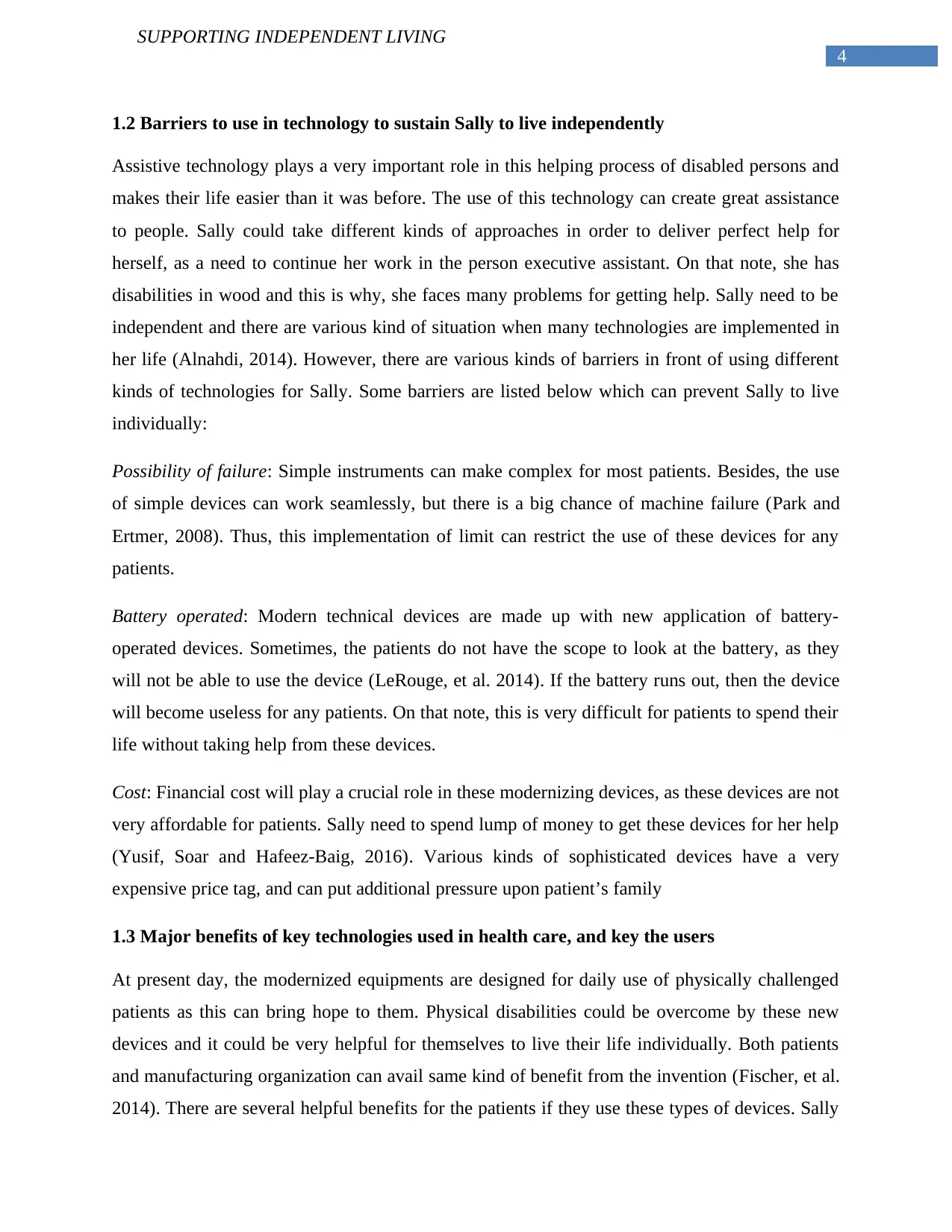
4
SUPPORTING INDEPENDENT LIVING
1.2 Barriers to use in technology to sustain Sally to live independently
Assistive technology plays a very important role in this helping process of disabled persons and
makes their life easier than it was before. The use of this technology can create great assistance
to people. Sally could take different kinds of approaches in order to deliver perfect help for
herself, as a need to continue her work in the person executive assistant. On that note, she has
disabilities in wood and this is why, she faces many problems for getting help. Sally need to be
independent and there are various kind of situation when many technologies are implemented in
her life (Alnahdi, 2014). However, there are various kinds of barriers in front of using different
kinds of technologies for Sally. Some barriers are listed below which can prevent Sally to live
individually:
Possibility of failure: Simple instruments can make complex for most patients. Besides, the use
of simple devices can work seamlessly, but there is a big chance of machine failure (Park and
Ertmer, 2008). Thus, this implementation of limit can restrict the use of these devices for any
patients.
Battery operated: Modern technical devices are made up with new application of battery-
operated devices. Sometimes, the patients do not have the scope to look at the battery, as they
will not be able to use the device (LeRouge, et al. 2014). If the battery runs out, then the device
will become useless for any patients. On that note, this is very difficult for patients to spend their
life without taking help from these devices.
Cost: Financial cost will play a crucial role in these modernizing devices, as these devices are not
very affordable for patients. Sally need to spend lump of money to get these devices for her help
(Yusif, Soar and Hafeez-Baig, 2016). Various kinds of sophisticated devices have a very
expensive price tag, and can put additional pressure upon patient’s family
1.3 Major benefits of key technologies used in health care, and key the users
At present day, the modernized equipments are designed for daily use of physically challenged
patients as this can bring hope to them. Physical disabilities could be overcome by these new
devices and it could be very helpful for themselves to live their life individually. Both patients
and manufacturing organization can avail same kind of benefit from the invention (Fischer, et al.
2014). There are several helpful benefits for the patients if they use these types of devices. Sally
SUPPORTING INDEPENDENT LIVING
1.2 Barriers to use in technology to sustain Sally to live independently
Assistive technology plays a very important role in this helping process of disabled persons and
makes their life easier than it was before. The use of this technology can create great assistance
to people. Sally could take different kinds of approaches in order to deliver perfect help for
herself, as a need to continue her work in the person executive assistant. On that note, she has
disabilities in wood and this is why, she faces many problems for getting help. Sally need to be
independent and there are various kind of situation when many technologies are implemented in
her life (Alnahdi, 2014). However, there are various kinds of barriers in front of using different
kinds of technologies for Sally. Some barriers are listed below which can prevent Sally to live
individually:
Possibility of failure: Simple instruments can make complex for most patients. Besides, the use
of simple devices can work seamlessly, but there is a big chance of machine failure (Park and
Ertmer, 2008). Thus, this implementation of limit can restrict the use of these devices for any
patients.
Battery operated: Modern technical devices are made up with new application of battery-
operated devices. Sometimes, the patients do not have the scope to look at the battery, as they
will not be able to use the device (LeRouge, et al. 2014). If the battery runs out, then the device
will become useless for any patients. On that note, this is very difficult for patients to spend their
life without taking help from these devices.
Cost: Financial cost will play a crucial role in these modernizing devices, as these devices are not
very affordable for patients. Sally need to spend lump of money to get these devices for her help
(Yusif, Soar and Hafeez-Baig, 2016). Various kinds of sophisticated devices have a very
expensive price tag, and can put additional pressure upon patient’s family
1.3 Major benefits of key technologies used in health care, and key the users
At present day, the modernized equipments are designed for daily use of physically challenged
patients as this can bring hope to them. Physical disabilities could be overcome by these new
devices and it could be very helpful for themselves to live their life individually. Both patients
and manufacturing organization can avail same kind of benefit from the invention (Fischer, et al.
2014). There are several helpful benefits for the patients if they use these types of devices. Sally
Paraphrase This Document
Need a fresh take? Get an instant paraphrase of this document with our AI Paraphraser
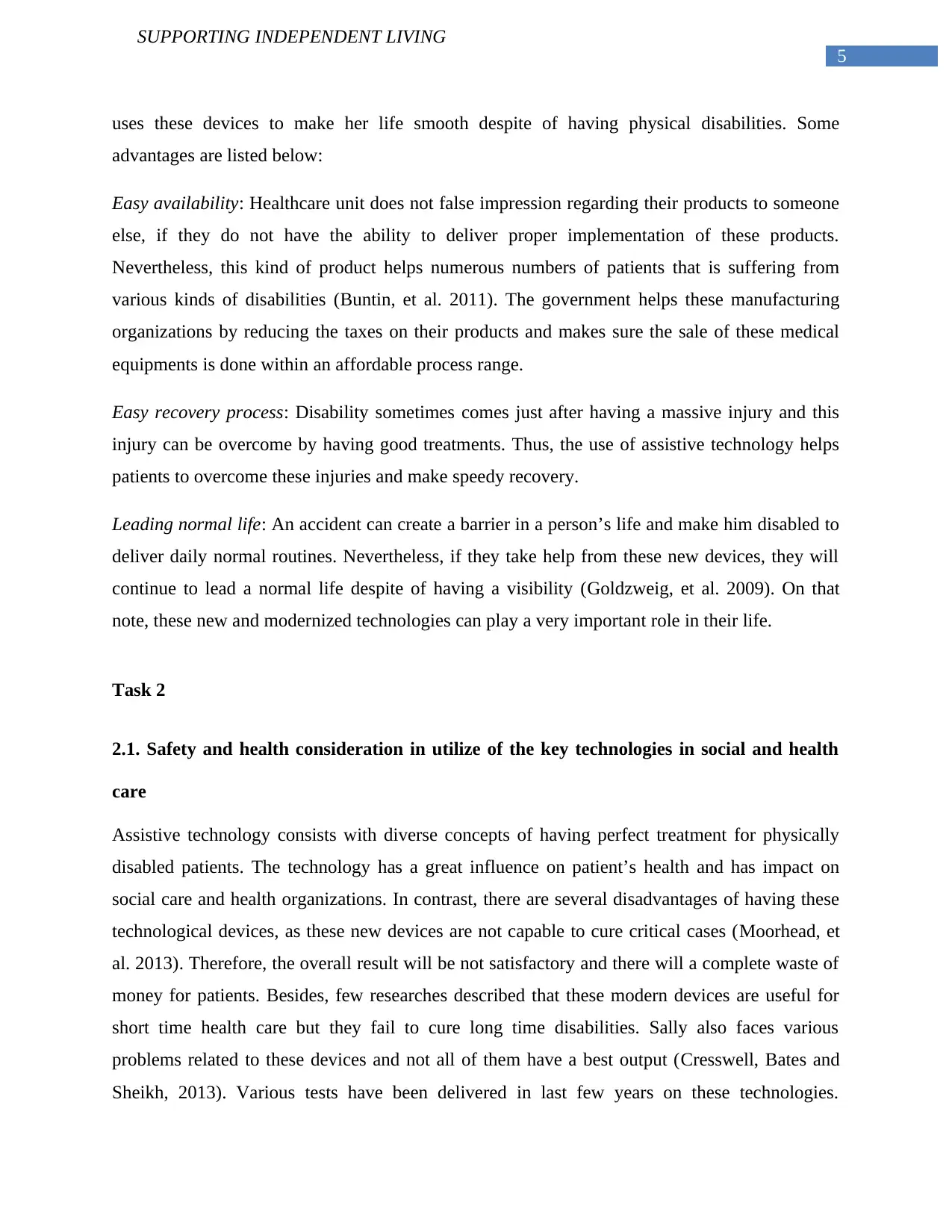
5
SUPPORTING INDEPENDENT LIVING
uses these devices to make her life smooth despite of having physical disabilities. Some
advantages are listed below:
Easy availability: Healthcare unit does not false impression regarding their products to someone
else, if they do not have the ability to deliver proper implementation of these products.
Nevertheless, this kind of product helps numerous numbers of patients that is suffering from
various kinds of disabilities (Buntin, et al. 2011). The government helps these manufacturing
organizations by reducing the taxes on their products and makes sure the sale of these medical
equipments is done within an affordable process range.
Easy recovery process: Disability sometimes comes just after having a massive injury and this
injury can be overcome by having good treatments. Thus, the use of assistive technology helps
patients to overcome these injuries and make speedy recovery.
Leading normal life: An accident can create a barrier in a person’s life and make him disabled to
deliver daily normal routines. Nevertheless, if they take help from these new devices, they will
continue to lead a normal life despite of having a visibility (Goldzweig, et al. 2009). On that
note, these new and modernized technologies can play a very important role in their life.
Task 2
2.1. Safety and health consideration in utilize of the key technologies in social and health
care
Assistive technology consists with diverse concepts of having perfect treatment for physically
disabled patients. The technology has a great influence on patient’s health and has impact on
social care and health organizations. In contrast, there are several disadvantages of having these
technological devices, as these new devices are not capable to cure critical cases (Moorhead, et
al. 2013). Therefore, the overall result will be not satisfactory and there will a complete waste of
money for patients. Besides, few researches described that these modern devices are useful for
short time health care but they fail to cure long time disabilities. Sally also faces various
problems related to these devices and not all of them have a best output (Cresswell, Bates and
Sheikh, 2013). Various tests have been delivered in last few years on these technologies.
SUPPORTING INDEPENDENT LIVING
uses these devices to make her life smooth despite of having physical disabilities. Some
advantages are listed below:
Easy availability: Healthcare unit does not false impression regarding their products to someone
else, if they do not have the ability to deliver proper implementation of these products.
Nevertheless, this kind of product helps numerous numbers of patients that is suffering from
various kinds of disabilities (Buntin, et al. 2011). The government helps these manufacturing
organizations by reducing the taxes on their products and makes sure the sale of these medical
equipments is done within an affordable process range.
Easy recovery process: Disability sometimes comes just after having a massive injury and this
injury can be overcome by having good treatments. Thus, the use of assistive technology helps
patients to overcome these injuries and make speedy recovery.
Leading normal life: An accident can create a barrier in a person’s life and make him disabled to
deliver daily normal routines. Nevertheless, if they take help from these new devices, they will
continue to lead a normal life despite of having a visibility (Goldzweig, et al. 2009). On that
note, these new and modernized technologies can play a very important role in their life.
Task 2
2.1. Safety and health consideration in utilize of the key technologies in social and health
care
Assistive technology consists with diverse concepts of having perfect treatment for physically
disabled patients. The technology has a great influence on patient’s health and has impact on
social care and health organizations. In contrast, there are several disadvantages of having these
technological devices, as these new devices are not capable to cure critical cases (Moorhead, et
al. 2013). Therefore, the overall result will be not satisfactory and there will a complete waste of
money for patients. Besides, few researches described that these modern devices are useful for
short time health care but they fail to cure long time disabilities. Sally also faces various
problems related to these devices and not all of them have a best output (Cresswell, Bates and
Sheikh, 2013). Various tests have been delivered in last few years on these technologies.
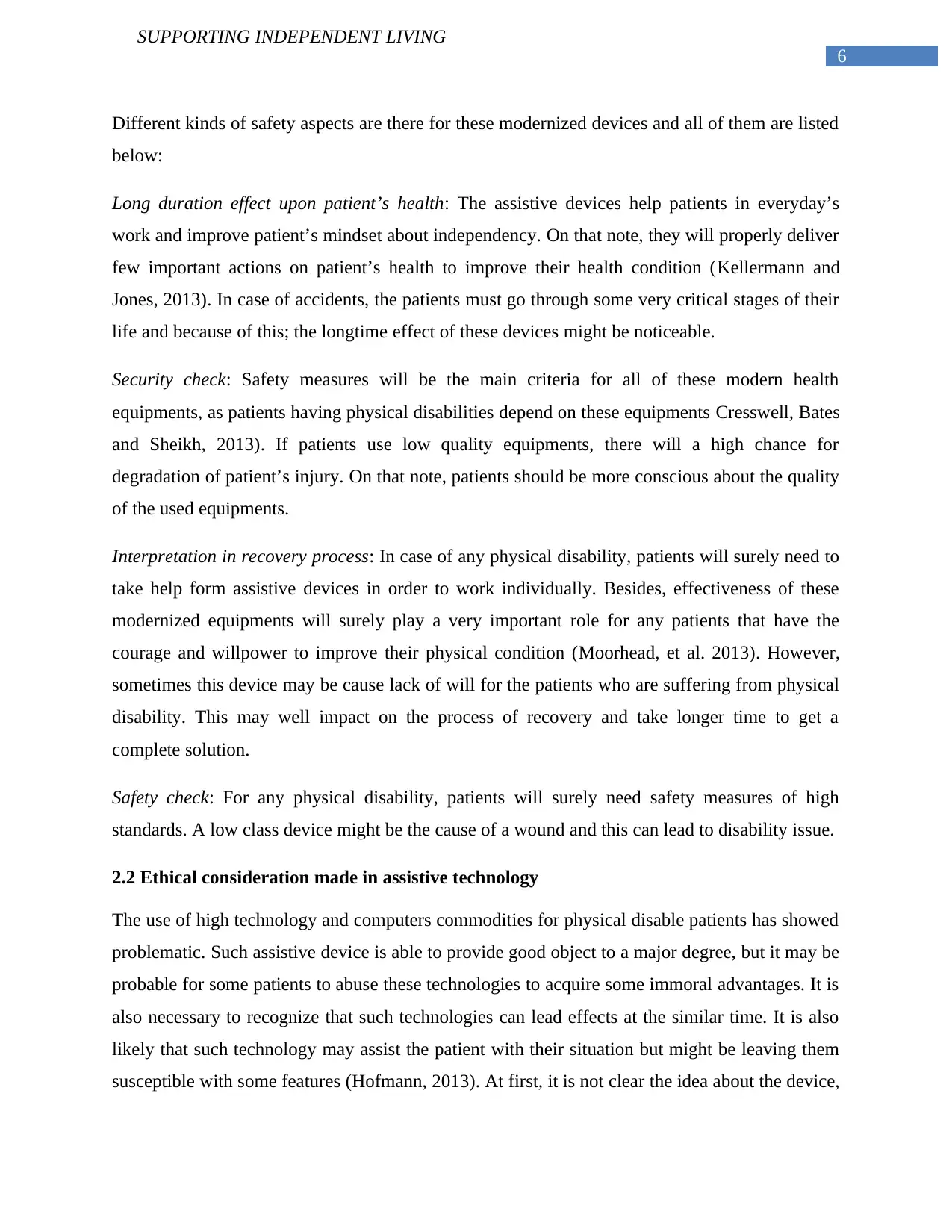
6
SUPPORTING INDEPENDENT LIVING
Different kinds of safety aspects are there for these modernized devices and all of them are listed
below:
Long duration effect upon patient’s health: The assistive devices help patients in everyday’s
work and improve patient’s mindset about independency. On that note, they will properly deliver
few important actions on patient’s health to improve their health condition (Kellermann and
Jones, 2013). In case of accidents, the patients must go through some very critical stages of their
life and because of this; the longtime effect of these devices might be noticeable.
Security check: Safety measures will be the main criteria for all of these modern health
equipments, as patients having physical disabilities depend on these equipments Cresswell, Bates
and Sheikh, 2013). If patients use low quality equipments, there will a high chance for
degradation of patient’s injury. On that note, patients should be more conscious about the quality
of the used equipments.
Interpretation in recovery process: In case of any physical disability, patients will surely need to
take help form assistive devices in order to work individually. Besides, effectiveness of these
modernized equipments will surely play a very important role for any patients that have the
courage and willpower to improve their physical condition (Moorhead, et al. 2013). However,
sometimes this device may be cause lack of will for the patients who are suffering from physical
disability. This may well impact on the process of recovery and take longer time to get a
complete solution.
Safety check: For any physical disability, patients will surely need safety measures of high
standards. A low class device might be the cause of a wound and this can lead to disability issue.
2.2 Ethical consideration made in assistive technology
The use of high technology and computers commodities for physical disable patients has showed
problematic. Such assistive device is able to provide good object to a major degree, but it may be
probable for some patients to abuse these technologies to acquire some immoral advantages. It is
also necessary to recognize that such technologies can lead effects at the similar time. It is also
likely that such technology may assist the patient with their situation but might be leaving them
susceptible with some features (Hofmann, 2013). At first, it is not clear the idea about the device,
SUPPORTING INDEPENDENT LIVING
Different kinds of safety aspects are there for these modernized devices and all of them are listed
below:
Long duration effect upon patient’s health: The assistive devices help patients in everyday’s
work and improve patient’s mindset about independency. On that note, they will properly deliver
few important actions on patient’s health to improve their health condition (Kellermann and
Jones, 2013). In case of accidents, the patients must go through some very critical stages of their
life and because of this; the longtime effect of these devices might be noticeable.
Security check: Safety measures will be the main criteria for all of these modern health
equipments, as patients having physical disabilities depend on these equipments Cresswell, Bates
and Sheikh, 2013). If patients use low quality equipments, there will a high chance for
degradation of patient’s injury. On that note, patients should be more conscious about the quality
of the used equipments.
Interpretation in recovery process: In case of any physical disability, patients will surely need to
take help form assistive devices in order to work individually. Besides, effectiveness of these
modernized equipments will surely play a very important role for any patients that have the
courage and willpower to improve their physical condition (Moorhead, et al. 2013). However,
sometimes this device may be cause lack of will for the patients who are suffering from physical
disability. This may well impact on the process of recovery and take longer time to get a
complete solution.
Safety check: For any physical disability, patients will surely need safety measures of high
standards. A low class device might be the cause of a wound and this can lead to disability issue.
2.2 Ethical consideration made in assistive technology
The use of high technology and computers commodities for physical disable patients has showed
problematic. Such assistive device is able to provide good object to a major degree, but it may be
probable for some patients to abuse these technologies to acquire some immoral advantages. It is
also necessary to recognize that such technologies can lead effects at the similar time. It is also
likely that such technology may assist the patient with their situation but might be leaving them
susceptible with some features (Hofmann, 2013). At first, it is not clear the idea about the device,
⊘ This is a preview!⊘
Do you want full access?
Subscribe today to unlock all pages.

Trusted by 1+ million students worldwide
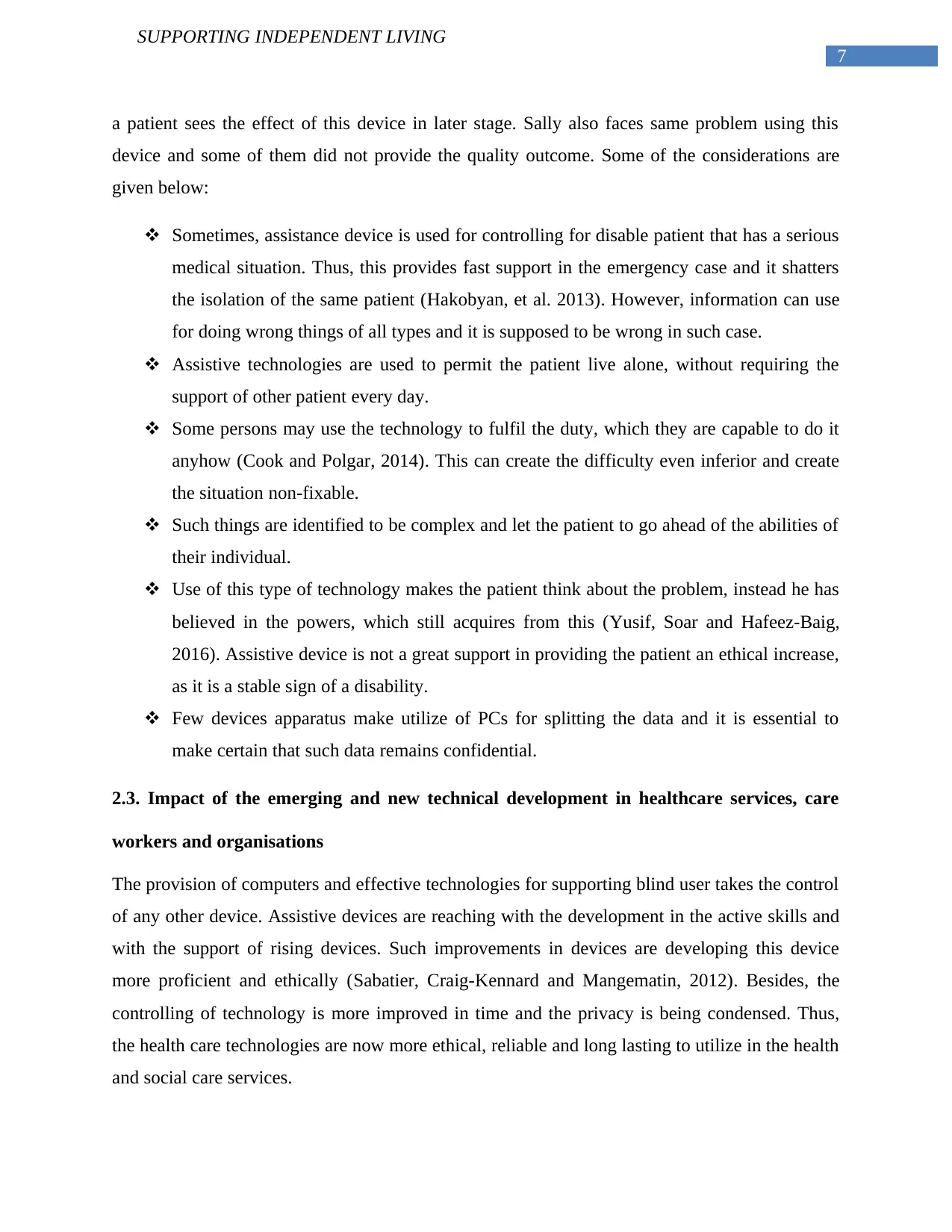
7
SUPPORTING INDEPENDENT LIVING
a patient sees the effect of this device in later stage. Sally also faces same problem using this
device and some of them did not provide the quality outcome. Some of the considerations are
given below:
Sometimes, assistance device is used for controlling for disable patient that has a serious
medical situation. Thus, this provides fast support in the emergency case and it shatters
the isolation of the same patient (Hakobyan, et al. 2013). However, information can use
for doing wrong things of all types and it is supposed to be wrong in such case.
Assistive technologies are used to permit the patient live alone, without requiring the
support of other patient every day.
Some persons may use the technology to fulfil the duty, which they are capable to do it
anyhow (Cook and Polgar, 2014). This can create the difficulty even inferior and create
the situation non-fixable.
Such things are identified to be complex and let the patient to go ahead of the abilities of
their individual.
Use of this type of technology makes the patient think about the problem, instead he has
believed in the powers, which still acquires from this (Yusif, Soar and Hafeez-Baig,
2016). Assistive device is not a great support in providing the patient an ethical increase,
as it is a stable sign of a disability.
Few devices apparatus make utilize of PCs for splitting the data and it is essential to
make certain that such data remains confidential.
2.3. Impact of the emerging and new technical development in healthcare services, care
workers and organisations
The provision of computers and effective technologies for supporting blind user takes the control
of any other device. Assistive devices are reaching with the development in the active skills and
with the support of rising devices. Such improvements in devices are developing this device
more proficient and ethically (Sabatier, Craig-Kennard and Mangematin, 2012). Besides, the
controlling of technology is more improved in time and the privacy is being condensed. Thus,
the health care technologies are now more ethical, reliable and long lasting to utilize in the health
and social care services.
SUPPORTING INDEPENDENT LIVING
a patient sees the effect of this device in later stage. Sally also faces same problem using this
device and some of them did not provide the quality outcome. Some of the considerations are
given below:
Sometimes, assistance device is used for controlling for disable patient that has a serious
medical situation. Thus, this provides fast support in the emergency case and it shatters
the isolation of the same patient (Hakobyan, et al. 2013). However, information can use
for doing wrong things of all types and it is supposed to be wrong in such case.
Assistive technologies are used to permit the patient live alone, without requiring the
support of other patient every day.
Some persons may use the technology to fulfil the duty, which they are capable to do it
anyhow (Cook and Polgar, 2014). This can create the difficulty even inferior and create
the situation non-fixable.
Such things are identified to be complex and let the patient to go ahead of the abilities of
their individual.
Use of this type of technology makes the patient think about the problem, instead he has
believed in the powers, which still acquires from this (Yusif, Soar and Hafeez-Baig,
2016). Assistive device is not a great support in providing the patient an ethical increase,
as it is a stable sign of a disability.
Few devices apparatus make utilize of PCs for splitting the data and it is essential to
make certain that such data remains confidential.
2.3. Impact of the emerging and new technical development in healthcare services, care
workers and organisations
The provision of computers and effective technologies for supporting blind user takes the control
of any other device. Assistive devices are reaching with the development in the active skills and
with the support of rising devices. Such improvements in devices are developing this device
more proficient and ethically (Sabatier, Craig-Kennard and Mangematin, 2012). Besides, the
controlling of technology is more improved in time and the privacy is being condensed. Thus,
the health care technologies are now more ethical, reliable and long lasting to utilize in the health
and social care services.
Paraphrase This Document
Need a fresh take? Get an instant paraphrase of this document with our AI Paraphraser
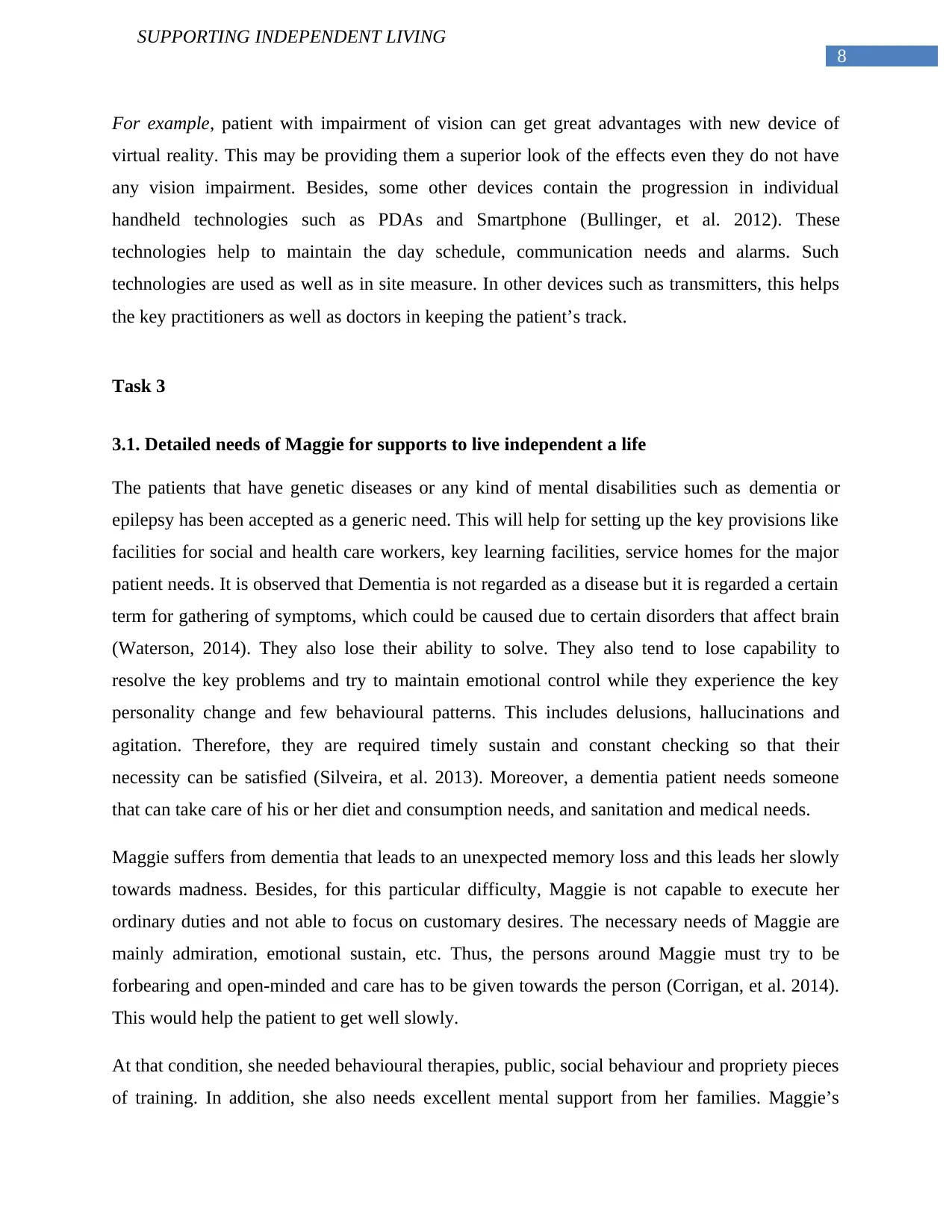
8
SUPPORTING INDEPENDENT LIVING
For example, patient with impairment of vision can get great advantages with new device of
virtual reality. This may be providing them a superior look of the effects even they do not have
any vision impairment. Besides, some other devices contain the progression in individual
handheld technologies such as PDAs and Smartphone (Bullinger, et al. 2012). These
technologies help to maintain the day schedule, communication needs and alarms. Such
technologies are used as well as in site measure. In other devices such as transmitters, this helps
the key practitioners as well as doctors in keeping the patient’s track.
Task 3
3.1. Detailed needs of Maggie for supports to live independent a life
The patients that have genetic diseases or any kind of mental disabilities such as dementia or
epilepsy has been accepted as a generic need. This will help for setting up the key provisions like
facilities for social and health care workers, key learning facilities, service homes for the major
patient needs. It is observed that Dementia is not regarded as a disease but it is regarded a certain
term for gathering of symptoms, which could be caused due to certain disorders that affect brain
(Waterson, 2014). They also lose their ability to solve. They also tend to lose capability to
resolve the key problems and try to maintain emotional control while they experience the key
personality change and few behavioural patterns. This includes delusions, hallucinations and
agitation. Therefore, they are required timely sustain and constant checking so that their
necessity can be satisfied (Silveira, et al. 2013). Moreover, a dementia patient needs someone
that can take care of his or her diet and consumption needs, and sanitation and medical needs.
Maggie suffers from dementia that leads to an unexpected memory loss and this leads her slowly
towards madness. Besides, for this particular difficulty, Maggie is not capable to execute her
ordinary duties and not able to focus on customary desires. The necessary needs of Maggie are
mainly admiration, emotional sustain, etc. Thus, the persons around Maggie must try to be
forbearing and open-minded and care has to be given towards the person (Corrigan, et al. 2014).
This would help the patient to get well slowly.
At that condition, she needed behavioural therapies, public, social behaviour and propriety pieces
of training. In addition, she also needs excellent mental support from her families. Maggie’s
SUPPORTING INDEPENDENT LIVING
For example, patient with impairment of vision can get great advantages with new device of
virtual reality. This may be providing them a superior look of the effects even they do not have
any vision impairment. Besides, some other devices contain the progression in individual
handheld technologies such as PDAs and Smartphone (Bullinger, et al. 2012). These
technologies help to maintain the day schedule, communication needs and alarms. Such
technologies are used as well as in site measure. In other devices such as transmitters, this helps
the key practitioners as well as doctors in keeping the patient’s track.
Task 3
3.1. Detailed needs of Maggie for supports to live independent a life
The patients that have genetic diseases or any kind of mental disabilities such as dementia or
epilepsy has been accepted as a generic need. This will help for setting up the key provisions like
facilities for social and health care workers, key learning facilities, service homes for the major
patient needs. It is observed that Dementia is not regarded as a disease but it is regarded a certain
term for gathering of symptoms, which could be caused due to certain disorders that affect brain
(Waterson, 2014). They also lose their ability to solve. They also tend to lose capability to
resolve the key problems and try to maintain emotional control while they experience the key
personality change and few behavioural patterns. This includes delusions, hallucinations and
agitation. Therefore, they are required timely sustain and constant checking so that their
necessity can be satisfied (Silveira, et al. 2013). Moreover, a dementia patient needs someone
that can take care of his or her diet and consumption needs, and sanitation and medical needs.
Maggie suffers from dementia that leads to an unexpected memory loss and this leads her slowly
towards madness. Besides, for this particular difficulty, Maggie is not capable to execute her
ordinary duties and not able to focus on customary desires. The necessary needs of Maggie are
mainly admiration, emotional sustain, etc. Thus, the persons around Maggie must try to be
forbearing and open-minded and care has to be given towards the person (Corrigan, et al. 2014).
This would help the patient to get well slowly.
At that condition, she needed behavioural therapies, public, social behaviour and propriety pieces
of training. In addition, she also needs excellent mental support from her families. Maggie’s
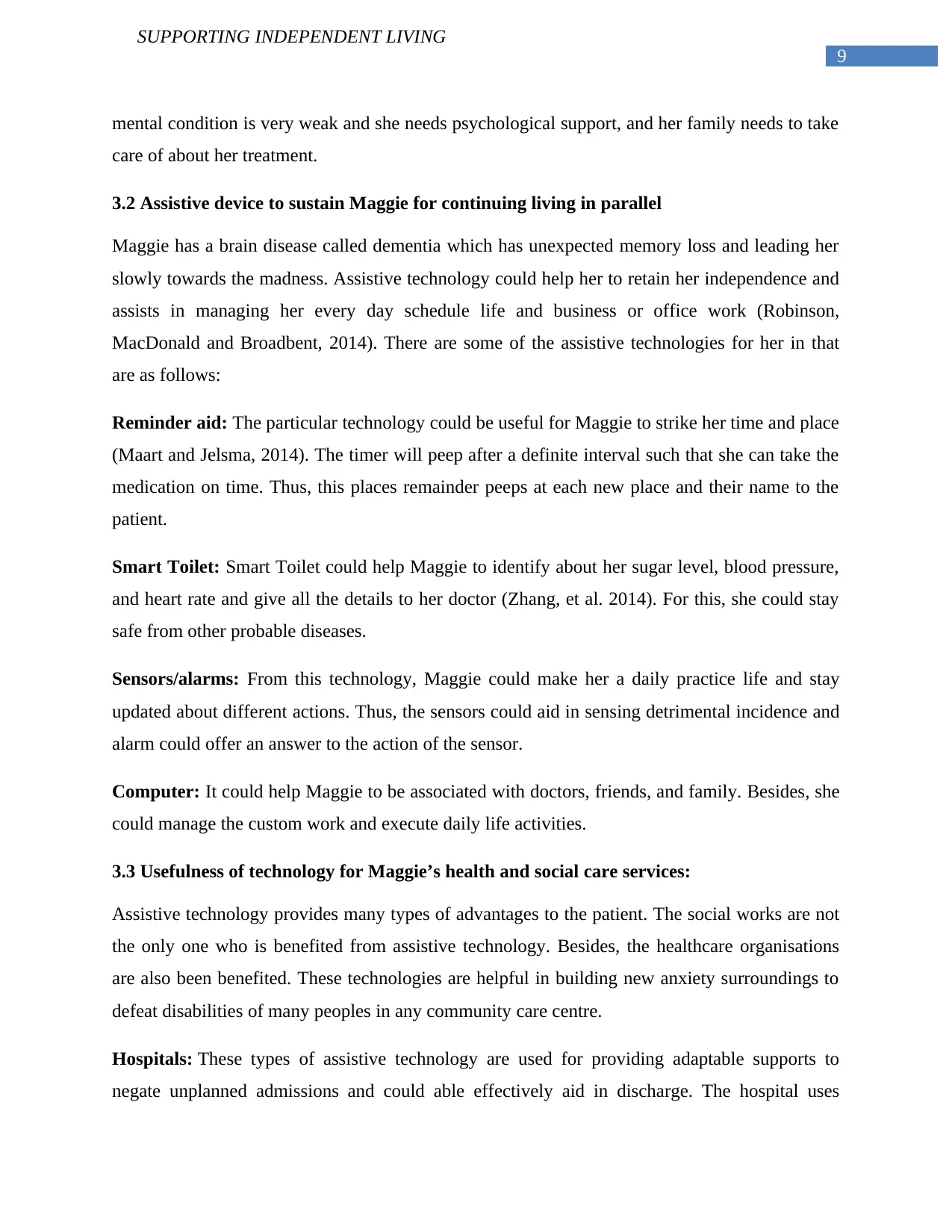
9
SUPPORTING INDEPENDENT LIVING
mental condition is very weak and she needs psychological support, and her family needs to take
care of about her treatment.
3.2 Assistive device to sustain Maggie for continuing living in parallel
Maggie has a brain disease called dementia which has unexpected memory loss and leading her
slowly towards the madness. Assistive technology could help her to retain her independence and
assists in managing her every day schedule life and business or office work (Robinson,
MacDonald and Broadbent, 2014). There are some of the assistive technologies for her in that
are as follows:
Reminder aid: The particular technology could be useful for Maggie to strike her time and place
(Maart and Jelsma, 2014). The timer will peep after a definite interval such that she can take the
medication on time. Thus, this places remainder peeps at each new place and their name to the
patient.
Smart Toilet: Smart Toilet could help Maggie to identify about her sugar level, blood pressure,
and heart rate and give all the details to her doctor (Zhang, et al. 2014). For this, she could stay
safe from other probable diseases.
Sensors/alarms: From this technology, Maggie could make her a daily practice life and stay
updated about different actions. Thus, the sensors could aid in sensing detrimental incidence and
alarm could offer an answer to the action of the sensor.
Computer: It could help Maggie to be associated with doctors, friends, and family. Besides, she
could manage the custom work and execute daily life activities.
3.3 Usefulness of technology for Maggie’s health and social care services:
Assistive technology provides many types of advantages to the patient. The social works are not
the only one who is benefited from assistive technology. Besides, the healthcare organisations
are also been benefited. These technologies are helpful in building new anxiety surroundings to
defeat disabilities of many peoples in any community care centre.
Hospitals: These types of assistive technology are used for providing adaptable supports to
negate unplanned admissions and could able effectively aid in discharge. The hospital uses
SUPPORTING INDEPENDENT LIVING
mental condition is very weak and she needs psychological support, and her family needs to take
care of about her treatment.
3.2 Assistive device to sustain Maggie for continuing living in parallel
Maggie has a brain disease called dementia which has unexpected memory loss and leading her
slowly towards the madness. Assistive technology could help her to retain her independence and
assists in managing her every day schedule life and business or office work (Robinson,
MacDonald and Broadbent, 2014). There are some of the assistive technologies for her in that
are as follows:
Reminder aid: The particular technology could be useful for Maggie to strike her time and place
(Maart and Jelsma, 2014). The timer will peep after a definite interval such that she can take the
medication on time. Thus, this places remainder peeps at each new place and their name to the
patient.
Smart Toilet: Smart Toilet could help Maggie to identify about her sugar level, blood pressure,
and heart rate and give all the details to her doctor (Zhang, et al. 2014). For this, she could stay
safe from other probable diseases.
Sensors/alarms: From this technology, Maggie could make her a daily practice life and stay
updated about different actions. Thus, the sensors could aid in sensing detrimental incidence and
alarm could offer an answer to the action of the sensor.
Computer: It could help Maggie to be associated with doctors, friends, and family. Besides, she
could manage the custom work and execute daily life activities.
3.3 Usefulness of technology for Maggie’s health and social care services:
Assistive technology provides many types of advantages to the patient. The social works are not
the only one who is benefited from assistive technology. Besides, the healthcare organisations
are also been benefited. These technologies are helpful in building new anxiety surroundings to
defeat disabilities of many peoples in any community care centre.
Hospitals: These types of assistive technology are used for providing adaptable supports to
negate unplanned admissions and could able effectively aid in discharge. The hospital uses
⊘ This is a preview!⊘
Do you want full access?
Subscribe today to unlock all pages.

Trusted by 1+ million students worldwide
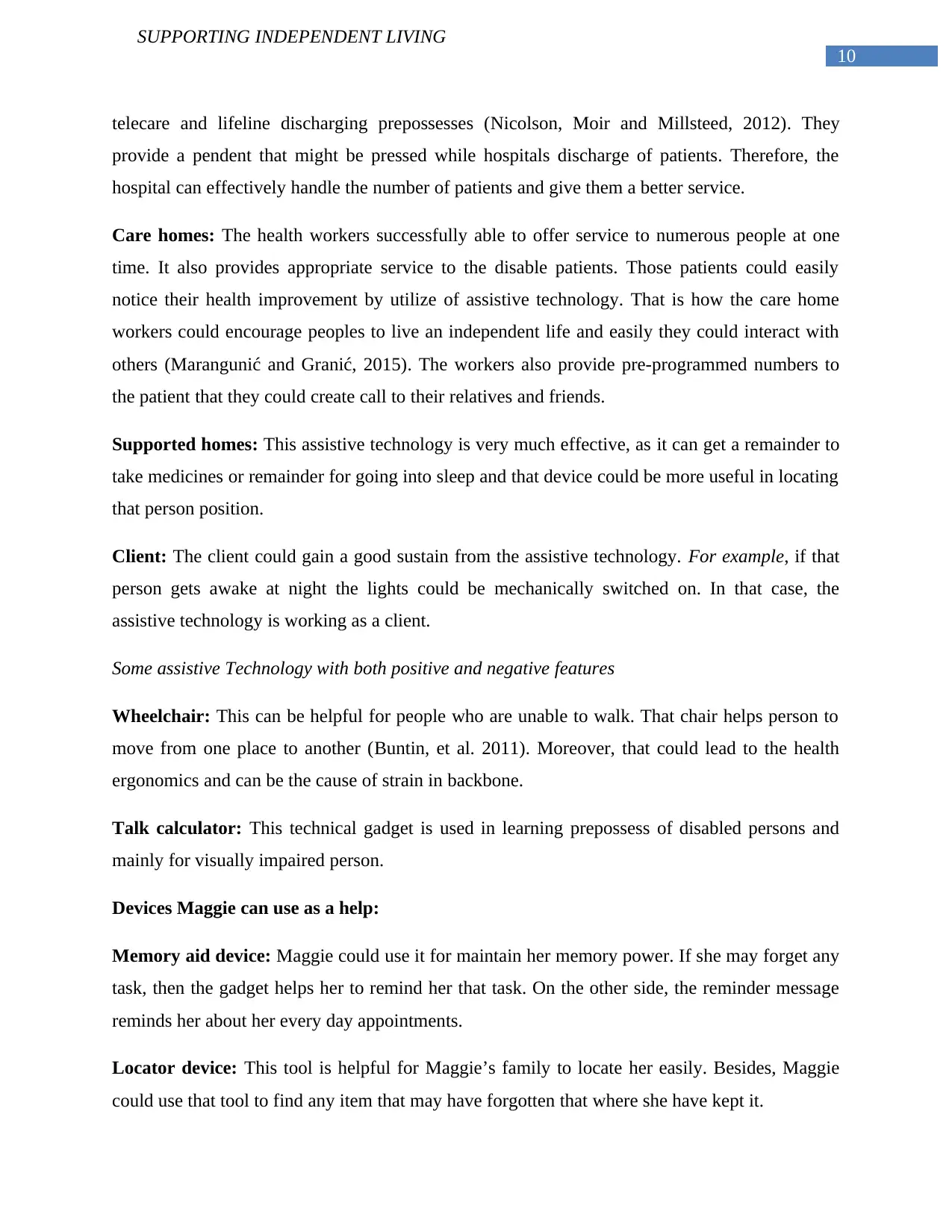
10
SUPPORTING INDEPENDENT LIVING
telecare and lifeline discharging prepossesses (Nicolson, Moir and Millsteed, 2012). They
provide a pendent that might be pressed while hospitals discharge of patients. Therefore, the
hospital can effectively handle the number of patients and give them a better service.
Care homes: The health workers successfully able to offer service to numerous people at one
time. It also provides appropriate service to the disable patients. Those patients could easily
notice their health improvement by utilize of assistive technology. That is how the care home
workers could encourage peoples to live an independent life and easily they could interact with
others (Marangunić and Granić, 2015). The workers also provide pre-programmed numbers to
the patient that they could create call to their relatives and friends.
Supported homes: This assistive technology is very much effective, as it can get a remainder to
take medicines or remainder for going into sleep and that device could be more useful in locating
that person position.
Client: The client could gain a good sustain from the assistive technology. For example, if that
person gets awake at night the lights could be mechanically switched on. In that case, the
assistive technology is working as a client.
Some assistive Technology with both positive and negative features
Wheelchair: This can be helpful for people who are unable to walk. That chair helps person to
move from one place to another (Buntin, et al. 2011). Moreover, that could lead to the health
ergonomics and can be the cause of strain in backbone.
Talk calculator: This technical gadget is used in learning prepossess of disabled persons and
mainly for visually impaired person.
Devices Maggie can use as a help:
Memory aid device: Maggie could use it for maintain her memory power. If she may forget any
task, then the gadget helps her to remind her that task. On the other side, the reminder message
reminds her about her every day appointments.
Locator device: This tool is helpful for Maggie’s family to locate her easily. Besides, Maggie
could use that tool to find any item that may have forgotten that where she have kept it.
SUPPORTING INDEPENDENT LIVING
telecare and lifeline discharging prepossesses (Nicolson, Moir and Millsteed, 2012). They
provide a pendent that might be pressed while hospitals discharge of patients. Therefore, the
hospital can effectively handle the number of patients and give them a better service.
Care homes: The health workers successfully able to offer service to numerous people at one
time. It also provides appropriate service to the disable patients. Those patients could easily
notice their health improvement by utilize of assistive technology. That is how the care home
workers could encourage peoples to live an independent life and easily they could interact with
others (Marangunić and Granić, 2015). The workers also provide pre-programmed numbers to
the patient that they could create call to their relatives and friends.
Supported homes: This assistive technology is very much effective, as it can get a remainder to
take medicines or remainder for going into sleep and that device could be more useful in locating
that person position.
Client: The client could gain a good sustain from the assistive technology. For example, if that
person gets awake at night the lights could be mechanically switched on. In that case, the
assistive technology is working as a client.
Some assistive Technology with both positive and negative features
Wheelchair: This can be helpful for people who are unable to walk. That chair helps person to
move from one place to another (Buntin, et al. 2011). Moreover, that could lead to the health
ergonomics and can be the cause of strain in backbone.
Talk calculator: This technical gadget is used in learning prepossess of disabled persons and
mainly for visually impaired person.
Devices Maggie can use as a help:
Memory aid device: Maggie could use it for maintain her memory power. If she may forget any
task, then the gadget helps her to remind her that task. On the other side, the reminder message
reminds her about her every day appointments.
Locator device: This tool is helpful for Maggie’s family to locate her easily. Besides, Maggie
could use that tool to find any item that may have forgotten that where she have kept it.
Paraphrase This Document
Need a fresh take? Get an instant paraphrase of this document with our AI Paraphraser
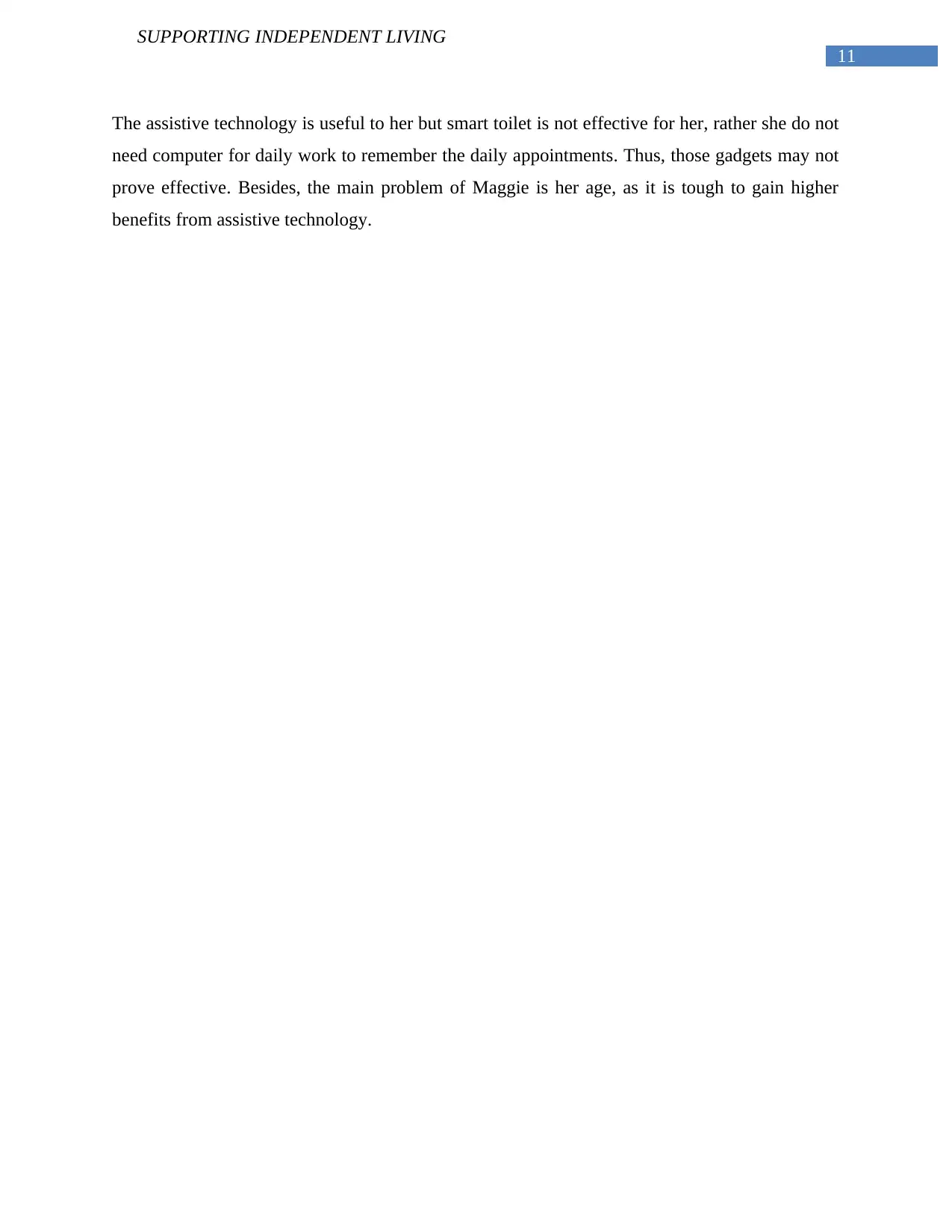
11
SUPPORTING INDEPENDENT LIVING
The assistive technology is useful to her but smart toilet is not effective for her, rather she do not
need computer for daily work to remember the daily appointments. Thus, those gadgets may not
prove effective. Besides, the main problem of Maggie is her age, as it is tough to gain higher
benefits from assistive technology.
SUPPORTING INDEPENDENT LIVING
The assistive technology is useful to her but smart toilet is not effective for her, rather she do not
need computer for daily work to remember the daily appointments. Thus, those gadgets may not
prove effective. Besides, the main problem of Maggie is her age, as it is tough to gain higher
benefits from assistive technology.
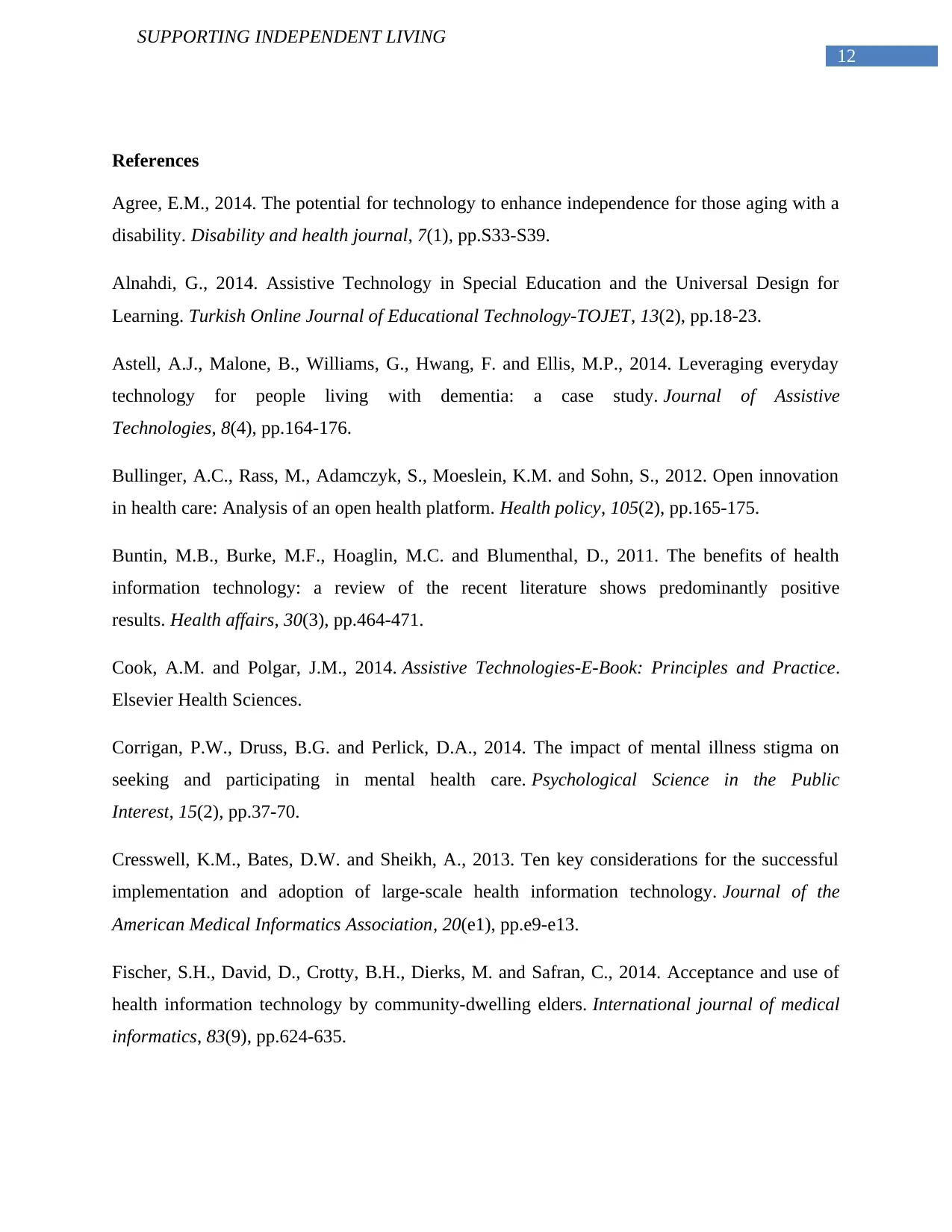
12
SUPPORTING INDEPENDENT LIVING
References
Agree, E.M., 2014. The potential for technology to enhance independence for those aging with a
disability. Disability and health journal, 7(1), pp.S33-S39.
Alnahdi, G., 2014. Assistive Technology in Special Education and the Universal Design for
Learning. Turkish Online Journal of Educational Technology-TOJET, 13(2), pp.18-23.
Astell, A.J., Malone, B., Williams, G., Hwang, F. and Ellis, M.P., 2014. Leveraging everyday
technology for people living with dementia: a case study. Journal of Assistive
Technologies, 8(4), pp.164-176.
Bullinger, A.C., Rass, M., Adamczyk, S., Moeslein, K.M. and Sohn, S., 2012. Open innovation
in health care: Analysis of an open health platform. Health policy, 105(2), pp.165-175.
Buntin, M.B., Burke, M.F., Hoaglin, M.C. and Blumenthal, D., 2011. The benefits of health
information technology: a review of the recent literature shows predominantly positive
results. Health affairs, 30(3), pp.464-471.
Cook, A.M. and Polgar, J.M., 2014. Assistive Technologies-E-Book: Principles and Practice.
Elsevier Health Sciences.
Corrigan, P.W., Druss, B.G. and Perlick, D.A., 2014. The impact of mental illness stigma on
seeking and participating in mental health care. Psychological Science in the Public
Interest, 15(2), pp.37-70.
Cresswell, K.M., Bates, D.W. and Sheikh, A., 2013. Ten key considerations for the successful
implementation and adoption of large-scale health information technology. Journal of the
American Medical Informatics Association, 20(e1), pp.e9-e13.
Fischer, S.H., David, D., Crotty, B.H., Dierks, M. and Safran, C., 2014. Acceptance and use of
health information technology by community-dwelling elders. International journal of medical
informatics, 83(9), pp.624-635.
SUPPORTING INDEPENDENT LIVING
References
Agree, E.M., 2014. The potential for technology to enhance independence for those aging with a
disability. Disability and health journal, 7(1), pp.S33-S39.
Alnahdi, G., 2014. Assistive Technology in Special Education and the Universal Design for
Learning. Turkish Online Journal of Educational Technology-TOJET, 13(2), pp.18-23.
Astell, A.J., Malone, B., Williams, G., Hwang, F. and Ellis, M.P., 2014. Leveraging everyday
technology for people living with dementia: a case study. Journal of Assistive
Technologies, 8(4), pp.164-176.
Bullinger, A.C., Rass, M., Adamczyk, S., Moeslein, K.M. and Sohn, S., 2012. Open innovation
in health care: Analysis of an open health platform. Health policy, 105(2), pp.165-175.
Buntin, M.B., Burke, M.F., Hoaglin, M.C. and Blumenthal, D., 2011. The benefits of health
information technology: a review of the recent literature shows predominantly positive
results. Health affairs, 30(3), pp.464-471.
Cook, A.M. and Polgar, J.M., 2014. Assistive Technologies-E-Book: Principles and Practice.
Elsevier Health Sciences.
Corrigan, P.W., Druss, B.G. and Perlick, D.A., 2014. The impact of mental illness stigma on
seeking and participating in mental health care. Psychological Science in the Public
Interest, 15(2), pp.37-70.
Cresswell, K.M., Bates, D.W. and Sheikh, A., 2013. Ten key considerations for the successful
implementation and adoption of large-scale health information technology. Journal of the
American Medical Informatics Association, 20(e1), pp.e9-e13.
Fischer, S.H., David, D., Crotty, B.H., Dierks, M. and Safran, C., 2014. Acceptance and use of
health information technology by community-dwelling elders. International journal of medical
informatics, 83(9), pp.624-635.
⊘ This is a preview!⊘
Do you want full access?
Subscribe today to unlock all pages.

Trusted by 1+ million students worldwide
1 out of 14
Related Documents
Your All-in-One AI-Powered Toolkit for Academic Success.
+13062052269
info@desklib.com
Available 24*7 on WhatsApp / Email
![[object Object]](/_next/static/media/star-bottom.7253800d.svg)
Unlock your academic potential
Copyright © 2020–2025 A2Z Services. All Rights Reserved. Developed and managed by ZUCOL.





